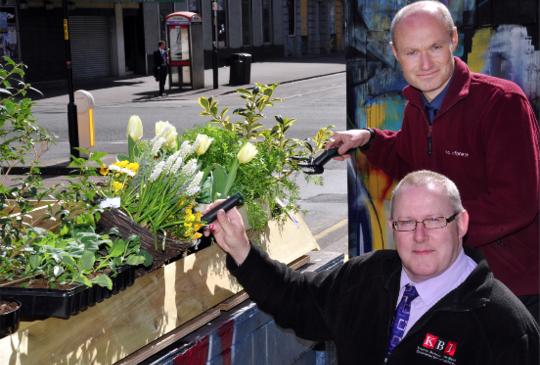
Crowd-funding success for Stevenson Square and Red Rose Forest
In 2013, Red Rose Forest embarked on an innovative bid to raise funds in order to give Stevenson Square, an urban area of bars, restaurants, offices and homes in Manchester’s Northern Quarter, a much needed green makeover.
The community forestry organisation was on a mission to plant street trees and establish an attractive green roof on the disused public toilets, for the benefit of residents, businesses, and those just passing through.
"I believe that greening our urban centres is essential to creating pleasant and attractive places in which to live, work and visit,” said Pete Stringer, Special Projects Manager for Red Rose Forest.
Planting more trees in urban areas has been shown to bring considerable advantages. It makes them less vulnerable to the effects of climate change and also brings an array of health benefits to the people living in those communities
Trees contribute to the removal of harmful pollutants from the air which are known to cause respiratory diseases, as well as the reduction of heat stress on hot summer’s days as they provide shade and evaporative cooling - making us feel calmer.

Trees can also reduce the risk of flooding in urban areas by intercepting rainfall on their leaves and in the ground around the base of the tree.
This results in less water accumulating on the street and prevents excess water from overloading engineered drainage systems.
The first funding contribution for this project was provided by Manchester City Council, however the project was still £6,000 short of what was needed to deliver all of the greening elements.
As a result, Red Rose Forest then worked with city centre management company CityCo and Manchester residents’ greening group, A New Leaf, on a successful internet crowd-funding campaign, in partnership with Spacehive, to raise the rest of the money.
This was the first greening project in Manchester City Centre to use internet-based crowd funding to raise funds and was a great success, with more than 80 local businesses and residents donating to the worthy cause.
11 Gingko biloba street trees have since been planted in the square in a newly resurfaced pavement. Each tree is surrounded by a permeable surface which contains recycled materials that allow water and oxygen to get down to the tree’s roots – this is essential for sustainable growth.
A lush green roof was also added to the public toilet block and consists of a range of ornamental grasses, as well as other plants including sedum, corn cockle, marjoram, thyme, and lobelia.
“We’re thrilled we have been able to make this project happen - it has made a huge difference to one of Manchester’s best known squares,” continued Pete.

“This project shows what a massive difference street trees can make to urban areas. But it’s about more than just making places look attractive and welcoming.
“Trees play a crucial role in helping cities like Manchester adapt to climate change, they can help clean the air and intercept rain to reduce the pressure on our overloaded drainage systems. . They have a central role to play in the life of every modern city.”
Councillor Pat Karney, Manchester City Council’s Lead Member for the City Centre added:
“In just a few months Stevenson Square has been given a completely new look. The addition of these beautiful trees, and the green roof on the toilet, have made the square feel much more inviting and attractive.
“The Northern Quarter as a whole is fast gaining a reputation as a dynamic part of the city centre. This greening project will encourage more people to discover what a great place it is to shop and eat out. It’s time for Stevenson Square to take its place among Manchester’s iconic destinations.”
If you would like to see a similar project in your community within Greater Manchester, please get in touch with Red Rose Forest via their website.
Contributor Profile
Grace is a writer and editor here at Platform and also works as a Copywriter at Creative Concern.
She graduated from The University of Nottingham in 2013 with a degree in English and Creative Writing and afterwards interned within the editorial department of a number of publications, before securing a position as Assistant Editor at a Manchester based magazine.



